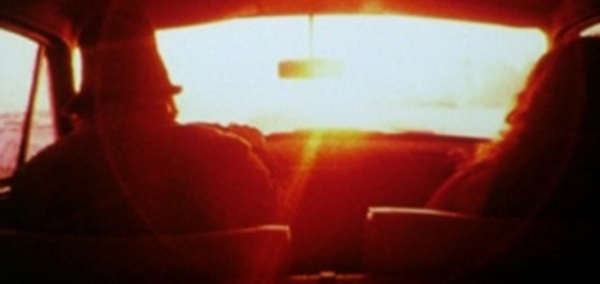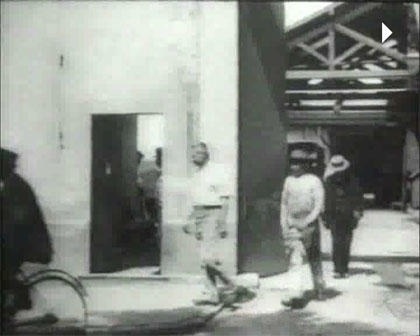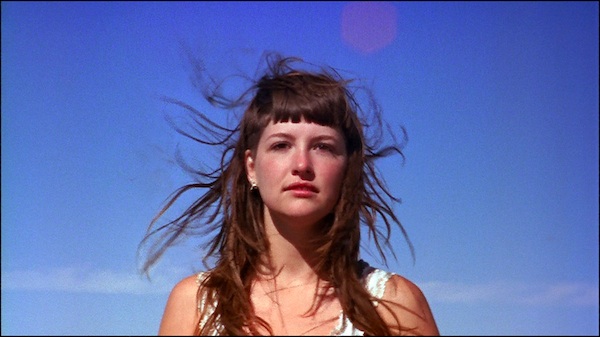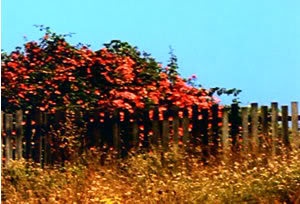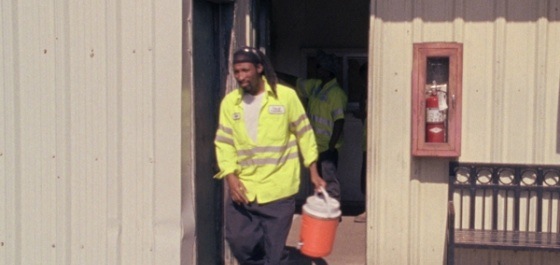One wonders if Louis and Auguste Lumière weren’t being a touch boastful when they described their first films as “actualités.” For the first time the passing moment could be fixed in time, turned into a noun. John Grierson would later conceive of the documentary as the “creative treatment of actuality,” positing the actuality as the uncooked constitutive element of documentary narration. As Scott MacDonald argued in his 1995 essay on the single-shot film, “Putting All Your Eggs in One Basket,” however, an overly teleological understanding of documentary history obscures the actuality’s enduring fascination for experimental filmmakers—something that remains true today for artists working on either side of the digital divide.
An early film like A Trip Down Market Street (1906) vividly illustrates the actuality’s allure. A camera is mounted on a streetcar for the ride down the length of San Francisco’s Market Street to its terminus at the Ferry Building. From this minimal design comes all manner of delightful complications. There is the sheer geometric intricacy of the straight streetcar track intersected by all the traffic criss-crossing the frame. There is the dynamic relationship between stillness (the posted camera) and movement (its locomotive conveyor). There is the way time mirrors space, with the Ferry Building coming to stand as a physical corollary of the end of the film and the time of the journey looping the audience’s experience of time watching it. There is the sheer density of historical documentation flitting past, all the more poignant with the knowledge that the film was shot only a week ahead of the 1906 earthquake. Most basically, there is the elegant parity of structure (the streetcar line, the length of the film) and chance (the chaos of the street). It’s no wonder structuralist filmmaker Ernie Gehr revived the film for his Eureka (1974).
One finds many of these same formal dualities in Ben Russell’s single-roll Trypps films, though there the collapsing of time and space tends to occur in the ontologically charged space of performance and psychedelic experience. Bruce Baillie’s All My Life (1966) offers an earlier example of the lyrical treatment of actuality. The three-minute film matches a single camera movement to Ella Fitzgerald’s titular song. The image circles around a pastoral California scene of wind in tall grass and an old wooden fence cutting the blue sky. Roses appear, first only a small bouquet’s worth and then suddenly as a wave of red. Buoyed in color and song, the camera effortlessly tilts up to sky before fading to black. The film tracks a movement from representation to abstraction, giving tangible form to the nature of reverie (I look at this flower, and suddenly I am in a dream). Baillie’s subjective vision is the “actuality” of this film, and it’s painted with only a few strokes.
All My Life was one of several avant-garde lodestars selected by California filmmaker Laida Lertxundi to accompany a program of her own work at the Ann Arbor Film Festival last week. It screened immediately following My Tears Are Dry (2009), a delicately crafted four-minute piece that cites Baillie’s original in its climactic camera movement and handwritten credits. Lertxundi’s movie opens with staccato cutting between a woman lying on a bed playing the first few bars of Hoagy Lands’ titular song on a portable cassette recorder and another woman on a couch idly strumming a guitar. A degree of tedium builds as we volley between these clipped images of listening and playing. When the Lands song is finally allowed to run its course, it comes as a sense of relief. A straightforward view of a quiet street tilts up towards the sky as Lands soars over the four words of the title. The camera comes to rest on the blue sky with palm tree still in the bottom left corner of the frame. Though obviously indebted to Baillie’s original, Lertxundi’s camera movement emerges from a distinct structure of frustration. And of course her shot never wholly surrenders gravity for pure sky. The waving palm tree remains, as if to tell us that the frame is not so readily overcome.
Several other gems at Ann Arbor charted new terrain for the actuality form. Kevin Jerome Everson’s Workers Leaving the Job Site is only the latest to recast the Lumières’ timeless Exiting the Factory. As with the original film, Everson’s version is silent and shot from a fixed exterior position. Unlike the original, the workers in Everson’s film exit their factory one at a time. We only see each face for a moment or two, but it’s long enough to register the differences in style and manner as they take their first steps off the clock. While the Lumière film is absorbed by the novelty of movement on a screen, in other words, Everson’s film is interested in how particular individuals move. Everson is prolific in many different formats, but his dense short program at Ann Arbor made it abundantly clear that he appreciates the directness of the actuality form as a way of building familiarity with places and performers.
JP Sniadecki and Libbie Cohn’s People’s Park was by far the most spectacular take on the actuality at Ann Arbor: a seventy five-minute unbroken camera movement through Chengdu’s populous park on a bright summer day. More than many of other bravura single-take films shot digitally, People’s Park derives tangible insights and layered beauty from its long drift. The film moves through many distinct scenes of leisure, though the ebullience of so much casual fraternizing is at times contested by an unnervingly dense sound design that extends well past the visible frame. Sniadecki and sound mixer Ernst Karel are both affiliated with Harvard’s Sensory Ethnography Lab, and People’s Park offers an exceptionally clear example of anthropology by other means: the encompassing quality of the film is equally aesthetic and sociological. The most consistent threads of attention are children, performers and the fantastic variety of looks back at the camera. Collecting these glances seems very much at the heart of People’s Park. As the film winds to its triumphant conclusion amidst a passionate troupe of dancers, the film’s own performance of documentary filmmaking finally enters a kind of communion with the subject onscreen.
Where People’s Park unfurls in a gloriously supple real time, Bette Gordon and James Benning’s The United States of America (1975), which screened at Ann Arbor in a restored print, compresses the entire cross-country drive in 27 minutes of screen time (just long enough to give a sense of how much country separates the coasts). The camera rides in the backseat, so we see Gordon and Benning driving and the oncoming landscape through the windshield’s frame. We dispatch with Manhattan in a few shots, the elliptical cutting pushing westward. The postcard progression plays brilliantly upon the sameness and difference of the road landscape, with the sparkling Pacific blue at the finish serving the same gravitational purpose as the Ferry Building in A Trip Down Market Street. The documentary quality of the film is greatly enhanced by its soundtrack: a radio collage of pop, regional music, dispatches from Vietnam, and preachers (we never hear Gordon or Benning speak). The natural landscape, already tempered by the highway system, is thus overlaid with the cultural landscape of the radio in the space film. Though the periodic construction suggests I Ching, there are plenty of witty rhymes (e.g. the golden arches of McDonald’s recalling the landmark Gateway of St. Louis) and deconstructions of the frame’s formal design (the unexpected lateral movement of passing trains).
Gordon and Benning’s film channels the playful psychogeography of the era’s West Coast conceptual art scene (wonderfully surveyed in last year’s State of Mind: New California Art Circa 1970 show at the Orange County Museum of Art and the Berkeley Art Museum), though it could just as easily be grouped with many of the classic counterculture road movies. As with the other Ann Arbor films examining narrow bands of reality, The United States of America suggests an underlying premise for thinking about the actuality: it’s the simplicity of the form that allows it to linger so.

